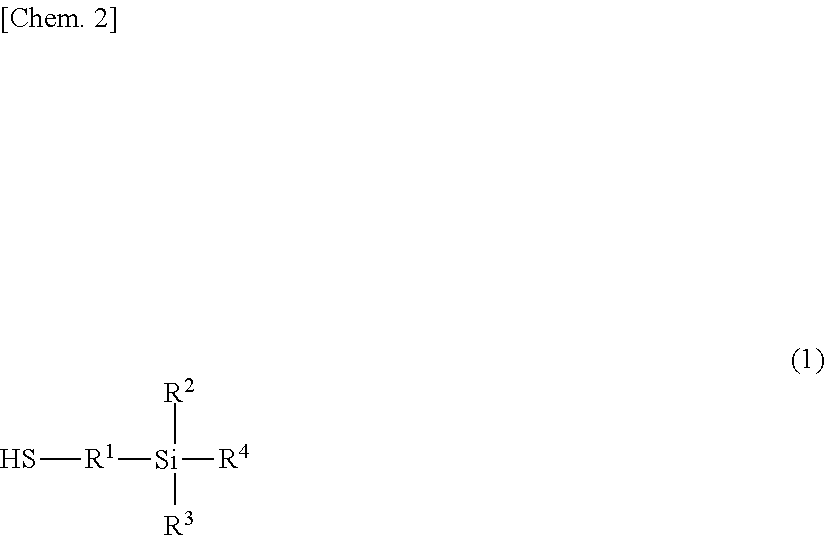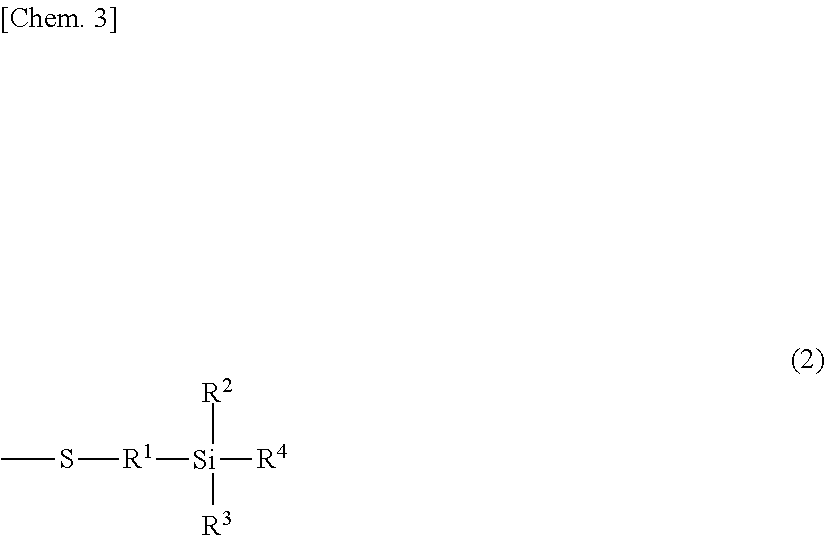Rubber compositions
a composition and rubber technology, applied in the field of rubber compositions, can solve the problems of poor dispersion of filler in crosslinked products, unsatisfactory enhancement of inability to achieve enhanced properties of crosslinked products, etc., to achieve enhanced rolling resistance performance, enhanced steering stability, and excellent mechanical strength
- Summary
- Abstract
- Description
- Claims
- Application Information
AI Technical Summary
Benefits of technology
Problems solved by technology
Method used
Image
Examples
production example 1
ed Liquid Diene Rubber (B-1)
[0160]A thoroughly dried 5 L autoclave was purged with nitrogen and was loaded with 1220 g of cyclohexane and 131 g of sec-butyllithium (a 10.5 mass % cyclohexane solution). After the temperature had been increased to 50° C., 1350 g of butadiene was added stepwise while performing stirring and while controlling the polymerization temperature at 50° C. Under such conditions, the polymerization was performed for 1 hour. The polymerization reaction was terminated by the addition of methanol. A polymer solution was thus obtained. Water was added to the polymer solution, and the mixture was stirred to wash the polymer solution with water. The stirring was terminated. After the liquid had separated into the polymer solution phase and the aqueous phase, the water was removed. After the completion of washing, the polymer solution was vacuum dried at 70° C. for 24 hours to afford an unmodified liquid diene rubber (B′-1).
[0161]Subsequently, a 1 L-volume autoclave w...
production example 2
ed Liquid Diene Rubber (B-2)
[0162]A thoroughly dried 5 L autoclave was purged with nitrogen and was loaded with 1280 g of cyclohexane and 66 g of sec-butyllithium (a 10.5 mass % cyclohexane solution). After the temperature had been increased to 50° C., 1350 g of butadiene was added stepwise while performing stirring and while controlling the polymerization temperature at 50° C. Under such conditions, the polymerization was performed for 1 hour. The polymerization reaction was terminated by the addition of methanol. A polymer solution was thus obtained. Water was added to the polymer solution, and the mixture was stirred to wash the polymer solution with water. The stirring was terminated. After the liquid had separated into the polymer solution phase and the aqueous phase, the water was removed. After the completion of washing, the polymer solution was vacuum dried at 70° C. for 24 hours to afford an unmodified liquid diene rubber (B′-2).
[0163]Subsequently, a 1 L-volume autoclave wa...
production example 3
ed Liquid Diene Rubber (B-3)
[0164]A thoroughly dried 5 L autoclave was purged with nitrogen and was loaded with 1280 g of cyclohexane and 66 g of sec-butyllithium (a 10.5 mass % cyclohexane solution). After the temperature had been increased to 50° C., 1350 g of butadiene was added stepwise while performing stirring and while controlling the polymerization temperature at 50° C. Under such conditions, the polymerization was performed for 1 hour. The polymerization reaction was terminated by the addition of methanol. A polymer solution was thus obtained. Water was added to the polymer solution, and the mixture was stirred to wash the polymer solution with water. The stirring was terminated. After the liquid had separated into the polymer solution phase and the aqueous phase, the water was removed. After the completion of washing, the polymer solution was vacuum dried at 70° C. for 24 hours to afford an unmodified liquid diene rubber (B′-3).
[0165]Subsequently, a 1 L-volume autoclave wa...
PUM
| Property | Measurement | Unit |
|---|---|---|
| melt viscosity | aaaaa | aaaaa |
| glass transition temperature | aaaaa | aaaaa |
| glass transition temperature | aaaaa | aaaaa |
Abstract
Description
Claims
Application Information
 Login to View More
Login to View More - R&D
- Intellectual Property
- Life Sciences
- Materials
- Tech Scout
- Unparalleled Data Quality
- Higher Quality Content
- 60% Fewer Hallucinations
Browse by: Latest US Patents, China's latest patents, Technical Efficacy Thesaurus, Application Domain, Technology Topic, Popular Technical Reports.
© 2025 PatSnap. All rights reserved.Legal|Privacy policy|Modern Slavery Act Transparency Statement|Sitemap|About US| Contact US: help@patsnap.com



